Variety in Art - What It Means Plus Master Examples
What Is Variety in Art?
Variety in art refers to the use of unlike qualities or instances of the visual elements. It is the opposite of repetitive or monotonous use of the elements.
Below is a great demonstration of diverseness by Tom Thomson. Notice all the different colors, lines, shapes, and brushwork. The end upshot is pleasing and interesting to wait at (the goal of most paintings).
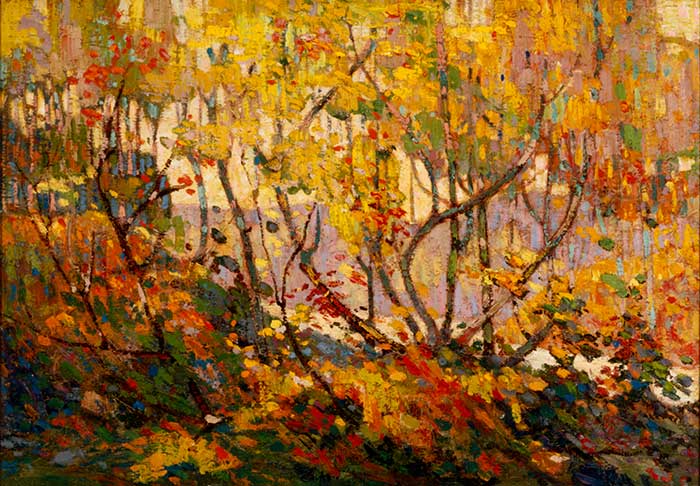
Tom Thomson, Opulent October, Winter, 1915
For the purpose of composition, beneath is a painting by Claude Monet which demonstrates a express variety of elements. But that is appropriate for this foggy depiction.

Claude Monet, The Palace of Westminster, The Fog Effect, 1903
(You might also be interested in my Painting Academy grade. I go into more detail on how to design interesting compositions for painting.)
Below I hash out some of the different ways you lot tin can incorporate variance into your paintings below.
Color Variance
There are iii primary ways you can vary your use of color:
- Value (how calorie-free or dark a color is);
- Saturation (how rich, vivid or intense a color is); or
- Hue (where a colour is located on the colour wheel).
Below is an instance of color variance in terms of value. In that location is hardly any modify in saturation or hue.

Camille Corot, The Gust of Wind, 1860
The stunning Impressionist painting beneath features color multifariousness mostly in terms of value and saturation. Light and saturated colors are used to depict your attention towards the focal bespeak in the painting, existence the faces of the four ladies. There is express hue variance, with mostly different crimson and yellow tones being used.

Abram Arkhipov, Visiting, 1915
Monet's work is a fantastic instance of hue variance. If you look closely at the painting below, notice all the singled-out colors—blues, purples, greens, reds, oranges, yellows.
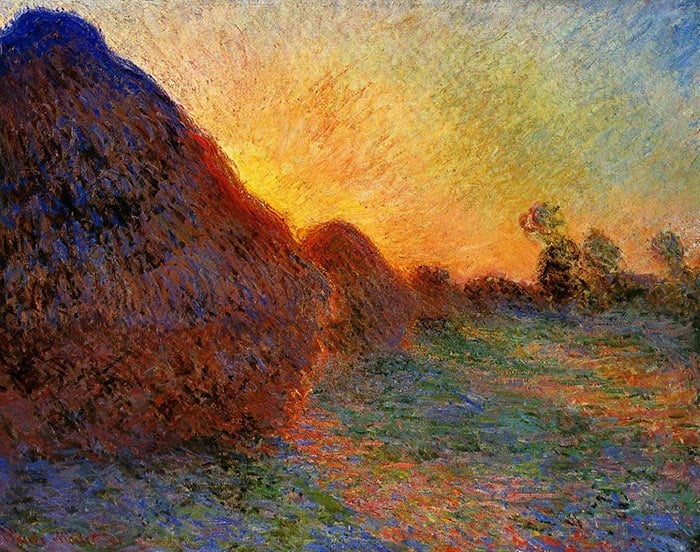
Claude Monet, Haystacks, 1891
Below is another example of color variance in terms of value and hue by Monet. There is a potent value contrast between the shadowed copse in the foreground and the high-primal groundwork. If yous narrow down on the background, notice how information technology is all painted within a very tight value range, but there is a wide variety of different hues (yellows, purples, greens, blues, oranges).

Claude Monet, Juan-Les-Pins, 1888
(If yous want to learn more about colour, make certain to grab my gratuitous Color Theory Cheat Canvas).
Line Variance
Line is peradventure the most fundamental of all the visual elements. It basically refers to a mark that spans between two points. Your lines can be:
- Thick or sparse
- Cleaved or continuous
- Long or short
- Straight or curved
In the remarkably realistic painting below past Ivan Shishkin, the trees class verticle lines throughout the painting which vary in terms of thickness, length, and color. Overly repetitive use of line in the painting would announced unnatural and rigid.
There is as well a pleasing contrast between all the verticle lines and the horizontal or diagonal lines formed by the edges of the path, river, grassy land, and the tree awning and floor.

Ivan Shishkin, In the Birch Tree Woods, 1883
Nicolai Fechin was a principal of line work. In his drawing below, notice the fragile and make clean lines used to outline the subject's face and features; the crude lines used for her pilus; the short, tapered lines used for her eyelashes; and the soft lines used for her lips and nose.
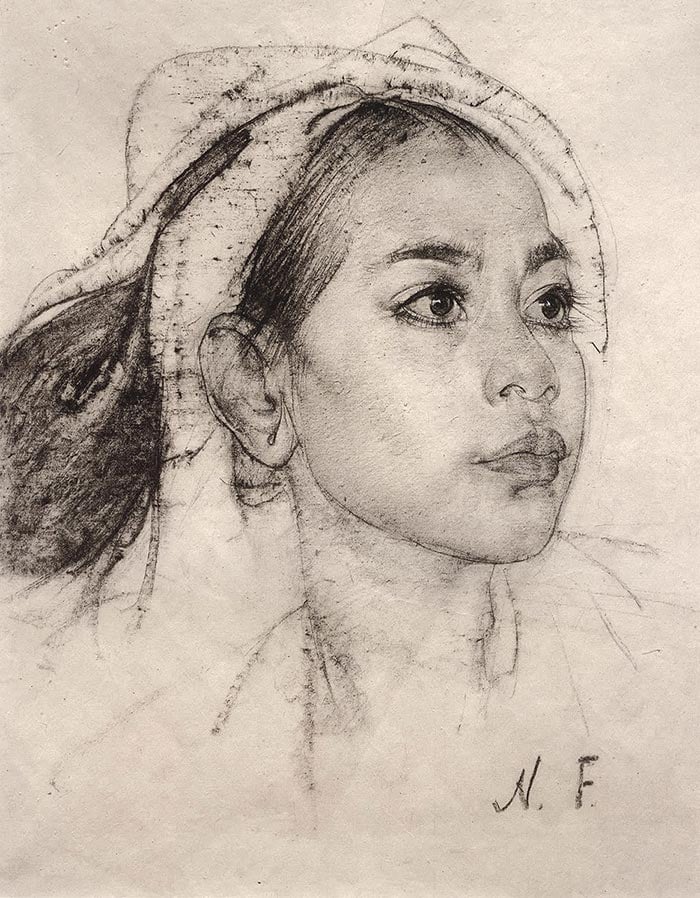
Nicolai Fechin, Drawing
Brushwork Variance
Many beginner painters tend to develop a bad addiction of overly repetitive brushwork. They use the same strokes over and over once again without thinking.
There are and so many different marks you lot can brand with your brush which vary based on:
- The style you hold your brush;
- The pressure level y'all use;
- The amount of paint you apply;
- The fluidity of the paint (how much medium you use);
- The surface you lot are painting on;
- How dry your brush is; and
- The angle of the castor.
Joaquín Sorolla'south work is a masterclass in brushwork. Look at the variety of his strokes in Bacchante beneath. Short, aggressive strokes are used for the background areas. More refined and blended strokes are used for the female around the center. Solid strokes are used for the deep blood-red wall in the corner. And then much brushwork variance, but it all seems cohesive and purposeful. I go a feeling of organized chaos.

Joaquin Sorolla, Bacchante, 1886
Fechin is some other artist who comes to mind when thinking of brushwork diversity. He used all kinds of strokes and tools to create his dynamic paintings.
In Lady in Lilac beneath, discover how about of the painting appears like nothing but an abstract arrangement of colors. Only equally a whole, it all seems to work. The intricate brushwork used for key features gives context to the residue of the painting.

Nicolai Fechin, Lady in Lilac, 1908
Technique Variance
Technique basically refers to the ways and methods past which you lot utilize paint to canvas. Some of the main techniques are scumbling, glazing, linework, and palette pocketknife work. But the but limit in this area is your imagination.
Joseph Turner's piece of work features a masterful range of techniques, from ambient scumbling to intricate linework. Below are three of his paintings. I suggest yous take a await through his piece of work to become some ideas of how y'all can incorporate varies techniques into your work whilst retaining a sense of cohesiveness. You lot should besides check out my post on his painting below, The Fighting Temeraire.
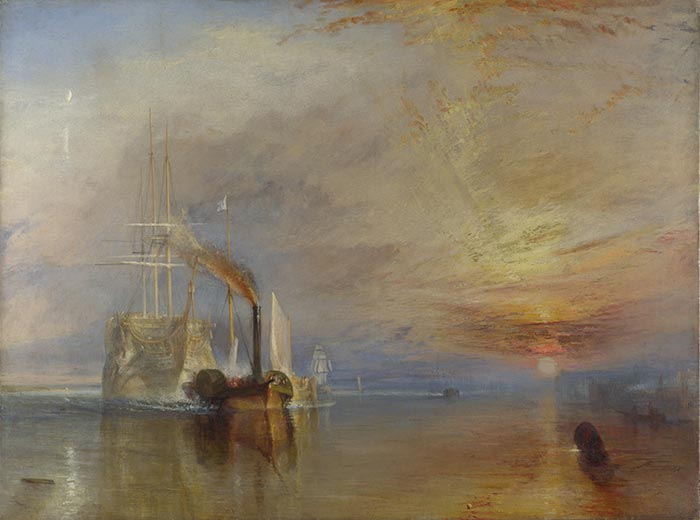
J.Chiliad.W. Turner, The Fighting Temeraire, 1838

J.M.Due west. Turner, Rain, Steam and Speed – The Great Western Railway, 1844
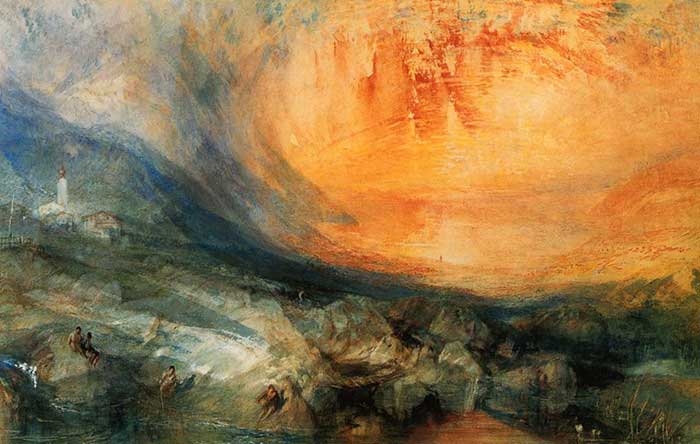
J.One thousand.W. Turner, Goldau, 1841
Shape Variance
Nothing stands out more a lack of shape variance. It tends to expect bland and unnatural if you employ the same circles or squares throughout your painting (unless you are painting rigid compages).
Your shapes can exist:
- Large or minor
- Geometric or organic
- Solid or weak
- Calorie-free or dark
- Colorful or dull
Shape is a strong feature in Claude Monet'sCurvation to the West from Etretat below. The cliff forms several stiff shapes in the positive and negative space (the positive space existence the cliff and the negative space being the sky in the background).

Claude Monet, Arch to the W from Etretat, 1883
I accept outlined these dominant shapes below. When I think near shape, I first think in terms of these dominant,big-picture shapes.

I can pause the ascendant shapes down into smaller, more intricate shapes, every bit shown below. Observe all the variety in these shapes; no two shapes are the same.

If yous want to run across more examples of shape variance, you lot should check out the work of Edgar Payne. He was a primary of using shape to draw the natural environs.

Edgar Alwin Payne, Sycamore in Autumn, Orange County Park, c.1917
Border Variance
An edge represents the transition betwixt two shapes. It can exist either hard, soft, or lost.
Edge variance is essential if y'all want to paint with a quality of realism. If you only utilize hard edges in your painting, so it volition look very harsh and rigid. If you only employ soft edges in your painting, then information technology will await blurry and out of focus.
Venice in the Fog by Sargent is a beautiful demonstration of edge variance, with soft edges used to depict the moody background, and hard edges used for the busy foreground.

John Vocalizer Sargent, Venice in the Fog, 1882
Below is another instance by Sargent. Notice how hard edges depict your attention towards the ragamuffin'due south out strung hand, which is a key feature of the painting.

John Singer Sargent, A Parisian Beggar Girl, 1877
Additional Readings
If y'all want to acquire more nearly this topic, y'all should bank check out my posts on the principles of art and the other visual elements.
Thanks for Reading!
Cheers for taking the fourth dimension to read this post. I appreciate it! Feel free to share with friends. If y'all desire more painting tips, check out my Painting University course.
Happy painting!

Dan Scott
Describe Pigment Academy
Source: https://drawpaintacademy.com/variety/
0 Response to "Variety in Art - What It Means Plus Master Examples"
Post a Comment